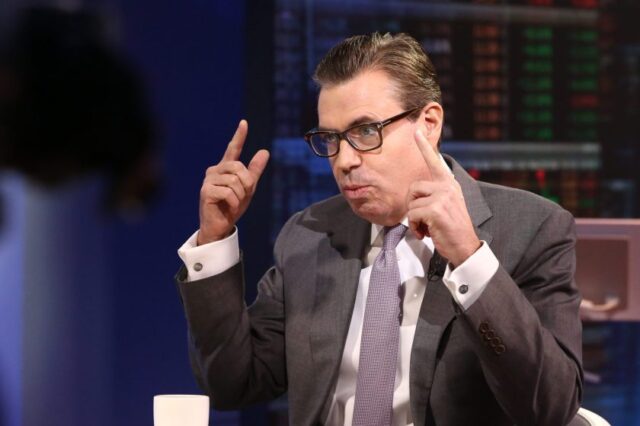
Jeffrey “Jeff” Currie, former global head of commodities research at Goldman Sachs, during a Bloomberg Television interview in New York on July 27, 2016. Christopher Goodney—Bloomberg/Getty Images
In 1981, the post-punk band New Order released an eerie single, “Everything’s Gone Green.” Known for their bizarre but occasionally profound lyrics, one particular refrain has relevance for green and environmental investing in 2024: “It feels like I’ve been here before.”
That’s the tune the market will sing this year, claims Jeff Currie, a famous “commodities guru” who stepped down from his role as the head of commodities research at Goldman Sachs last August, ending a storied 27-year career at the investment bank. Even now, Currie remains one of the most respected commodities experts in the world—and he sees the green landscape of the pre-inflation times returning, with energy prices set to rise in 2024.
Since 2020, Currie, who now serves as the chair of the advisory board at the University of Chicago Energy Institute, has warned that commodities will experience a “supercycle” driven by three key factors—redistributional policies, environmental policies, and deglobalization. And, in a further echo of the New Order classic, he told Bloomberg on Monday that “everybody’s going to be green again with inflation back down.”
It all has to do with one big takeaway from the huge spurt of inflation in 2021 and 2022, Currie said, and one big call he got wrong. Green energy supporters “were unwilling to pay for their politics,” and that meant energy prices didn’t spike as Currie forecasted.
He blamed this on politicians’ flip-flops on green policies worldwide, as well as several other factors, but warned Monday that the era of fading commodity prices won’t last.
Green when inflation is low, not so much with high inflation
Before the world was hit with a wave of inflation in 2021, green energy policies were front and center for President Biden. In 2019, Biden, then a leading Democratic candidate in the presidential race, promised to “end fossil fuel” after activists challenged him for accepting donations from the founder of a liquefied natural gas company.
But when oil prices surged in the wake of the Ukraine war in 2022, the president was quick to release oil from the strategic petroleum reserve and take a softer stance toward the fossil fuel industry. In the years since, he has approved a controversial $8 billion oil-drilling project in Alaska, auctioned off a territory the size of Arizona in the Gulf of Mexico to oil producers, and supported the Mountain Valley Pipeline that will transport fracked natural gas from Appalachia.
It’s not just U.S. politicians whose green policies have become far more lenient in recent years, either. Governments and businesses worldwide “turned a blind on eye on coal use, a blind eye on oil use,” Currie said Monday, noting that coal usage in Indonesia, India, and China is at an all-time high.
Currie said that even “the Europeans quit spending on renewables and green investments and redirected that cap-ex into the gulf of Mexico” to produce more oil in recent years, but the shift away from green policies is coming to an end. Many of these moves were simply “one-off” decisions made due to rising inflation, he argued, and renewed interest in green energy as inflation fades will help keep oil prices elevated in 2024.
To his point, more than 200 leaders from around the world attended the United Nations’ COP28 summit in the UAE last month and agreed, once again, to transition away from fossil fuels. In the world’s first ‘global stocktake,’ members of the COP28 agreed to “ratchet up climate action before the end of the decade,” according to the UN.
2023’s bygone ‘immaculate disinflation’
Currie pointed to a few other key factors that helped commodity prices fall over the past few years which are likely to do the opposite in 2024.
First, he said that supply and demand fundamentals for oil are “not that bad.” Global oil demand is set to rise to a record annual high of 102.9 million barrels per day in 2024, according to the International Energy Agency. Inventories are also “low,” spare capacity has been “exhausted” outside of the UAE and Saudi Arabia, and the one-off supply increase from President Biden’s release of 180 million barrels of oil from the strategic petroleum reserve won’t be around, Currie explained.
On top of that, China is apt to stimulate its economy in 2024 with monetary and fiscal policy, which should boost oil demand. “A lot of the disinflation that’s coming around the world is coming out of China,” Currie said, warning that this is likely to end in 2024.
And finally, central bank interest rate hikes in the West have helped keep a lid on demand for oil and other key commodities, but that’s over now.
“With the ‘immaculate disinflation,’ what you have is a likelihood that central banks around the West are going to cut [interest] rates. You do that, you’re teeing yourself up for a fantastic 2024,” Currie said, referring to the potential rise in oil prices.
For Currie, “the set-up we have going into 2024 is classic end of cycle, which is stating you always want to own commodities.” With the return of green energy policies, rising commodity prices could mean the end of the U.S.’s “immaculate disinflation.” But it will also feel like we’ve been here before—because everybody will be going green again.




